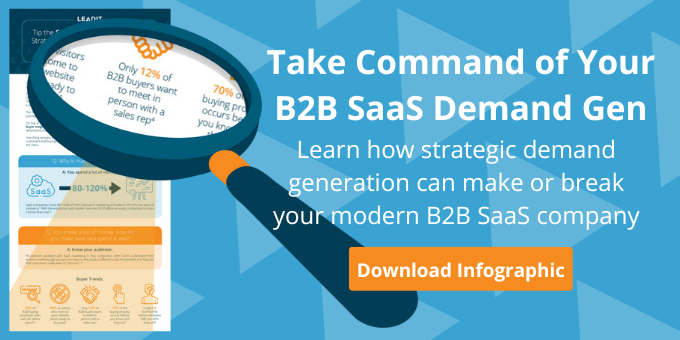Creating Cohesive Messages With Integrated Marketing
From social media to emails and everything in between, your customers are watching you. Every message your sales and marketing teams send out is a reflection of your brand.
But what happens when the email newsletter team is not collaborating with the social media team? While the messages the two teams are sending out may not conflict, it may feel like your brand has multiple personalities.
Whether you are struggling with:
- An unwieldy, large marketing department,
- Sales and marketing teams that do not align, or
- An overloaded small marketing team,
Integrated marketing can help you plan all your pieces together by creating a cohesive message and campaigns that yield great results — more loyal customers.
Marketing Silos in Big B2B Tech Organizations
In big companies, there are silos even within the marketing teams. Teams that focus on content, email, and social might be so focused on their work that they do not collaborate.
This creates a broken link between campaigns and can be a missed opportunity to capture new leads. It takes anywhere from 6-8 touches to create a viable sales lead, which means your potential customers may see a blog post, two emails, and four social media posts before giving you their information.
Collaborating and creating content that connects will allow your potential customers to connect the dots more quickly as to why your solution solves their current problems.
By breaking down these silos and collaborating with your various marketing teams you give your potential customers the most cohesive brand experience possible.
Discovering The Missing Piece Of Your B2B Marketing Strategy
Many B2B businesses are missing a united sales and marketing team when it comes to their integrated marketing. This piece, if missing, can keep you from targeting the right audience and effectively gaining loyal customers.
When sales and marketing work together, your audience will see and hear a cohesive message over all of your platforms.
Fueling your sales team with marketing messages requires regular meetings and moments for collaboration and communication. Learn how you can keep your marketing and sales team grounded in goals by watching our Webinar: How to Create A Marketing and Sales Engine + Keep It Running.
Overloaded Marketing Teams in Small B2B Tech Companies
Smaller companies usually mean smaller marketing teams. Smaller teams often mean they are spread thin, especially when they don’t have the right skill set for every aspect of their marketing needs.
As your marketing team struggles to keep up with demand, integrated marketing becomes a dream, not an achievable goal. Place coordinating campaigns at the forefront of their minds by planning with multiple channels in mind from the start.
Your marketing team knows your target audience; in a small team, there’s a greater chance they have even spoken to your customers. Take those findings and optimize content that already exists.
Unsure how to optimize existing content? As an example, take an ebook you already have and:
- Write a blog post promoting it
- Develop multiple videos about each aspect of the ebook and promote across Instagram, LinkedIn, and TikTok
- Craft an email for your sales email to use, offering the ebook as a resource for your prospective customers
While your marketing team may be small, it can be mighty with some careful planning and leveraging of existing content.
Piecing Together Your B2B Tech Integrated Marketing and Campaigns
Question: How can you consistently piece together your integrated marketing and campaigns?
Answer: coordinating and communicating!
A cohesive and effective integrated marketing plan begins with just that- a plan. Focus on the customer and how they buy. If you’re not sure where your customer is going to look for solutions to their problem areas, talk to your current customers!
Keep in mind that B2B customers look at multiple channels many times before they even consider committing to a sale.
Your plans should cover things like:
- Platforms to use:
-
-
- What type of content does your target audience like to engage with?
- Of the platforms you are currently using, which ones are currently performing well? How can you optimize your content on those platforms?
- What platforms are you not currently using? Are your customers searching for solutions on that platform?
- Think about how you can create and cross-promote content on various platforms. (For example, you can film a 5-minute YouTube video which you could edit down and repost on TikTok and Instagram)
-
- Content plans:
-
-
- What are your customers struggling with most right now?
- What topics would you like to cover over the next quarter and year?
-
- Goals for campaigns:
-
- What does success look like?
- What KPIs should you be tracking on a weekly, monthly, and yearly basis?
The further out you can plan the better. Planning a quarter or a year in advance will allow you to have a birds-eye view of your integrated marketing. It will allow your marketing team to zoom out from their individual projects and see how their deliverables weave into the greater marketing plan.
Adding to Your B2B Tech Integrated Marketing and Campaigns
Once you have an integrated marketing plan in place, keep an eye on your engagement and stay agile.
Based on what your audience is responding to, you may need to make adjustments to your plan either in real-time or for the next quarter. These changes may include:
- Add marketing channels to your campaigns – What channels are you not utilizing? Does your target audience engage with some you don’t have?
- Follow the buyers – Buyers’ trends are always shifting, so use your crafted buyer personas to discover things like how your buyers consume content and where they search for information. Remember to update your buyer personas regularly throughout the year.
- Look at your data from past integrated campaigns – Hubspot says “Successful integrated marketing efforts often rest on lessons learned from previous campaigns.” Take the time to carefully and thoughtfully look over your data.
Adding to your integrated marketing and campaigns will help you stand out from your competition and connect with customers.
Complete Your B2B Integrated Marketing Puzzle
Keeping on top of your integrated marketing and campaigns to make sure the puzzle has all its pieces can be overwhelming.
At Leadit Marketing, we break down our marketing strategy plans into five segments:
- Target Marketing
- Messaging and Value Proposition
- Content Marketing
- Sales and Marketing Alignment
- Integrated Marketing and Campaigns
Interested in learning more about how each segment of marketing should fold into your B2B tech marketing strategy? Download our EBook: Synergized Marketing Is An Energized Bottom Line.














